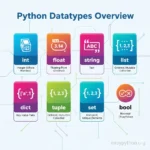Ever tried looking for your TV remote, only to find it in the fridge? Yeah, life’s weird. But Python doesn’t do “lost remotes”—it has dictionaries. And dictionaries in Python are like your super-organized best friend: they know exactly where every single thing is, and they’ll hand it over in lightning speed ⚡… unless you ask for something they don’t have—then they just roll their eyes and yell KeyError.
So, let’s dive into the Python Dictionary Data Type, the not-so-secret weapon behind clean, efficient code. And don’t worry—I’ll keep it fun. No boring textbook vibes here.
What is a Python Dictionary?
A dictionary in Python is basically a storage box for data… but with a twist. Instead of numbering your items like lists (list[0], list[1]), dictionaries store data as key-value pairs.
Think of it like this:
- Key = Name tag 🏷️
- Value = The actual thing 🎁
Example:
my_dict = {
"name": "Azeem",
"job": "Python Blogger",
"likes": "Coffee ☕"
}Ask for my_dict["job"] → Boom: "Python Blogger".
Simple. Fast. Drama-free.
👉 If you’re curious about other Python data types like lists, tuples, and sets, check out this Python Collection Types Overview.
Creating Dictionaries in Python
Python gives you multiple ways (because why not confuse beginners, right?).
Method 1: Using Curly Braces {}
person = {"name": "Alice", "age": 25}Method 2: Using the dict() Constructor
person = dict(name="Alice", age=25)Both work. But {} is the cool, popular cousin.
Accessing Data in a Dictionary
Imagine asking your mom where your socks are. She knows. That’s how dictionaries work.
person = {"name": "Bob", "age": 30}
print(person["name"]) # BobBut if you ask for something that doesn’t exist…
print(person["height"])
# KeyError: 'height'Instead, use .get() like a polite human:
print(person.get("height", "Not found"))
# Not foundUpdating and Adding Data
Dictionaries don’t mind new guests.
person["city"] = "Tokyo"
person["age"] = 31Boom. Updated and ready.
Deleting Stuff
del person["age"]→ deletes a keyperson.pop("city")→ deletes and returns the valueperson.clear()→ nuke everything
Python Dictionary Methods You Should Know
Here’s your cheat sheet:
keys()→ Returns all the keysvalues()→ Returns all the valuesitems()→ Returns both keys and valuesupdate()→ Merges another dictcopy()→ Makes a shallow copyfromkeys()→ Creates a dict from a list of keys
👉 For a full breakdown, peep the Python Built-in Functions and Modules List.
Nested Dictionaries
Yes, dictionaries can hold… dictionaries.
students = {
"101": {"name": "Ali", "grade": "A"},
"102": {"name": "Sara", "grade": "B"}
}Accessing:
students["101"]["name"] # AliNested dictionaries are like family drama: messy but sometimes necessary.
Dictionary Comprehensions
Why write long code when you can flex one-liners?
squares = {x: x**2 for x in range(5)}
# {0: 0, 1: 1, 2: 4, 3: 9, 4: 16}It’s like list comprehensions but with an extra touch of nerdiness.
Performance: Why Dictionaries Are Speed Demons
Here’s the secret sauce: dictionaries are built on hash tables. That means:
- Lookup time is O(1) (on average).
- Which is a fancy way of saying → they’re ridiculously fast.
If you’re the type who loves numbers and efficiency charts, the Python Official Docs explain it in very serious detail.
Real-Life Use Cases of Python Dictionaries
- Counting word frequencies in text
- JSON-like data storage
- Configuration settings
- Caching results (because redoing work is for peasants 🫡)
Example: Word counter
text = "python python coffee python code coffee"
counter = {}
for word in text.split():
counter[word] = counter.get(word, 0) + 1
print(counter)
# {'python': 3, 'coffee': 2, 'code': 1}Wrapping It Up
Python dictionaries are the ultimate cheat code: fast, flexible, and ridiculously useful. If lists are your wardrobe (organized by numbers), dictionaries are your butler who remembers where everything is.
And trust me, once you get comfortable with them, you’ll start using dictionaries everywhere—whether it’s for user input handling, string manipulations, or even mapping out your Python learning roadmap.
So go ahead—flex your new dict superpowers. And remember: if you ever forget something, Python’s KeyError will remind you in its passive-aggressive way.
💡 Pro Tip: If you’re serious about mastering Python (and want to sound fancy at developer meetups), grab a solid resource from these Python Books.




